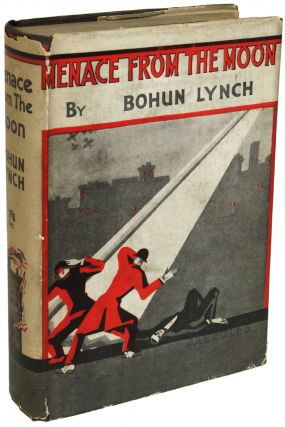
British writer, artist. Oxford Graduate. Several books on boxing: The Complete Amateur Boxer (1913 and later editions), Knuckles and Gloves (1922), The Prize Ring (1925). Also A History of Caricature (1926). Edited supernatural anthology A Muster of Ghosts (1924, which is covered in The Guide to Supernatural Fiction.
1381. MENACE FROM THE MOON. Jarrolds; London, 1925. Anon. ill.
World peril, partly in the mode of a house party mystery story, partly in the manner of the early H. G. Wells. * England and the Tridentina region of Italy. * The narrator, who is staying with friends on Dartmoor, loses his way in a heavy fog and is forced to spend most of the night on the treacherous moor. His uneasiness at being lost, however, is less than his panic when he sees overhead, in the clouds, a gigantic human face accompanied by squiggly lines. He is shaken, doubting his own sanity, but is reassured when others report having seen the same phenomenon. Indeed, when the appearance is repeated and seen from an airplane, it becomes important to science. * The first explanation offered is that the picture and the message (the lines) were projected from Mars, but Lancelot Downey, brilliant young Professor of Physics at Oxford, educes the correct explanation: The symbols are developments of a logical calculus devised by Bishop Wilkins in the seventeenth century, and the message is from the moon. * As deciphered, it discloses that a band of earthmen including the historical Cornelis Drebbel and his family flew to the moon in the seventeenth century and settled there. Obviously, the Lunarians have since developed a science superior to ours. But now they are asking for help, since an unidentified disaster is about to befall them. The calculus cannot be verbally precise, but that is the gist of the message. * A succeeding message urges the earthmen to find the spaceship plans that the seventeenth-century scientists left behind. Copies of the plans should be hidden in their homes: Drebbel’s in Oxford, Kitto’s at Gadstock, and Paoloni’s in the Dolomitic Alps. Since Kitto’s establishment was razed long ago, and Drebbel’s is not precisely known, Paoloni’s is the only choice. * It is all in vain. The narrator searches in Italy, but finds nothing except danger. The papers have not survived. Oxford, too, turns out to be a blind alley. The secret of the spaceship has been lost. * While the search is going on, messages from the moon continue, becoming more and more hostile. The Lunarians (who seem to have evolved into a nasty race), taking the position that, the earthmen are callously ignoring them, threaten to bombard the earth with deadly rays. Indeed, they have already flashed a heat ray onto several places, with horrible results. * There are panic, religious revivals, riots, and socialist agitation as the moon continues to make token attacks. The situation grows more serious when the Lunarians destroy Nantes with a heat ray and draw a huge circle around London, blasting everything away. An ultimatum of a few days is running out. * At the height of the panic, Downey calls a conference of leading politicians and makes an astonishing statement: The menace from the moon is ended. There were only forty Lunarians left, as one message had stated, and they were blown up in an atomic explosion when they blasted the circle around London. Downey has worked out figures proving that the amount of atomic disintegration needed for the destruction would have started a chain reaction and blown up the projector. * And, most surprising of all, Downey reveals that the explosion took place about a year ago. All the messages, all the attacks were really dispatched long ago, but were impeded by the interplanetary ether. It took them a year to reach earth. The Lunarians, despite their superscience, did not know of this effect, whence their impatience at not receiving answers to their messages. As Downey reminds his audience, the lunar explosion was seen a year earlier by a South American astronomer whose story was discredited at the time.
*Ingenious, literate, but somewhat clumsily handled.
SOURCE: Bleiler, Everet F. Science-fiction, the Early Years: a Full Description of More Than 3,000 Science-Fiction Stories from Earliest Times to the Appearance of the Genre Magazines in 1930, with the assistance of Richard J. Bleiler (Kent, OH: Kent State University Press, 1990), pp. 456-457.
Note: Boldface added by RD.

Menace from the Moon. London: Jarrolds, 1925. Science fiction novel involving John Wilkins’s Universal Character.
Menace from the Moon (1925 novel) - Wikipedia, the free encyclopedia
The Menace from the Moon (by Bohun Lynch): A review by Georges T. Dodds (SF Site, 2002)
Lynch, Bohun (SFE, April 27, 2017)
Karinthy, Frigyes (1887-1938) by Everet F. Bleiler
Esperanto in early science fiction to 1930 by Everet F. Bleiler
J. U. Giesy (John Ulrich, 1877-1948) & His Collaborators
Philosophical and Universal Languages, 1600-1800, and Related Themes: Selected Bibliography
Science Fiction & Utopia Research Resources: A Selective Work in Progress
Home Page | Site Map |
What's New | Coming
Attractions | Book News
Bibliography | Mini-Bibliographies
| Study Guides | Special
Sections
My Writings | Other
Authors' Texts | Philosophical Quotations
Blogs | Images
& Sounds | External Links
CONTACT Ralph Dumain
Uploaded 27 October 2021
Site ©1999-2021 Ralph Dumain